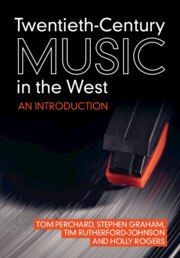Book contents
- Twentieth-Century Music in the West
- Twentieth-Century Music in the West
- Copyright page
- Contents
- Figures
- Tables
- Acknowledgements
- Introduction
- Part I Histories
- Part II Techniques and Technologies
- 5 Work and Notation
- 6 Rhythm and Time
- 7 Harmony
- 8 Instruments
- Part III Mediation
- Part IV Identities
- Bibliography
- Index
5 - Work and Notation
from Part II - Techniques and Technologies
Published online by Cambridge University Press: 15 September 2022
- Twentieth-Century Music in the West
- Twentieth-Century Music in the West
- Copyright page
- Contents
- Figures
- Tables
- Acknowledgements
- Introduction
- Part I Histories
- Part II Techniques and Technologies
- 5 Work and Notation
- 6 Rhythm and Time
- 7 Harmony
- 8 Instruments
- Part III Mediation
- Part IV Identities
- Bibliography
- Index
Summary
The concept of the work of art is – at least in the West – ‘the fundamental category of aesthetics’ (Dahlhaus 1987: 210; see also Dahlhaus 1982, 1989 and 1990). Yet although we often talk about musical ‘works’, it is hard to say what one actually is. In the visual arts, it is easier: the work is generally an object – a painting or a sculpture, perhaps an installation. In literature, it is usually a book. These are things at which we can point: they have definite borders and are fixed in space and/or time. Works are also thought to contain within them all that is necessary for their appreciation, a fact that situates them in a particular functional relationship between the artist, the audience and (in the case of music) the performer. The work, therefore, not only serves as art’s central object of contemplation and creation but also determines the social, functional and economic hierarchy between who creates it, who realises it and who appreciates it.
- Type
- Chapter
- Information
- Twentieth-Century Music in the WestAn Introduction, pp. 131 - 153Publisher: Cambridge University PressPrint publication year: 2022

